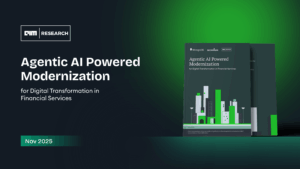The journey of Generative AI has been very exciting for industries and still we have scratched just the tip of the iceberg. Technologies like ChatGPT and Stable diffusion have already transformed many facets of our personal and professional lives, opening the door to a promising future filled with boundless opportunities. However, it’s essential to recognize that we are merely at the outset of this digital age. As we progress further into this era, the influence of generative AI innovations is poised to become even more substantial, fundamentally altering our society in manners that are beyond our current comprehension.
The transformative potential of this remarkable technology on our daily lives and professional endeavors is already evident. UK energy provider Octopus Energy reports that AI now handles 44% of its customer service inquiries, while the CEO of software company Freshworks highlights how tasks that once consumed eight to 10 weeks are now accomplished within days through the integration of AI tools into their workflows.
Nevertheless, it’s crucial to recognize that we are merely scratching the surface. In the foreseeable weeks, months, and years, we can anticipate a rapid acceleration in the development of novel generative AI forms. These innovations will continue to expand their capabilities, taking on a growing array of tasks and enhancing our abilities in ways that may appear as astonishing to us as the advent of ChatGPT and similar tools did just a few months ago.
Shaping the Future of Content, Design, and Interactive Experiences
Generative AI, whether in text, image, or video, is poised to redefine numerous aspects of our lives and work. While the current capabilities are already remarkable, the next wave of generative AI models, surpassing the likes of GPT-4, promises a deeper understanding of psychology and the creative process. This will enable AI to produce written content that is not only more engaging but also richer in originality. As AI tools like AutoGPT evolve, allowing AI to generate its own prompts, complex tasks will become more achievable, expanding the horizons of what generative AI can accomplish.
Looking forward, generative AI will play a pivotal role in shaping how we interact with digital information and immersive environments. Predictions point toward immersive 3D experiences through VR/AR, with generative AI speeding up the design and development of these complex environments. Realistic avatars will further enhance these experiences. In music and voice, generative AI will empower musicians with novel compositions and enable real-time, adaptive soundtracks. AI voice synthesis will approach human levels of expression, opening doors to real-time translation and automated voiceovers. In design and product creation, AI-driven generative design tools will revolutionize the process, making intricate object and system creation more accessible. Finally, the world of video games will undergo a transformation, with generative AI assisting in crafting immersive environments and dynamic content, ushering in a new era of gaming experiences. Generative AI’s influence across these domains promises a future defined by innovation and efficiency.
Navigating Ethical Concerns, Detection Strategies, and Societal Impact
In the past, the authenticity of online video and audio content was largely unquestioned. However, this is no longer the case. Nowadays, identifying deepfakes has become a nuanced blend of artistic discernment and scientific scrutiny. The pervasive influence of deepfake technology is manifesting in society, carrying potentially devastating consequences that could become increasingly evident if left unchecked. This technology represents a troubling exploitation of AI and machine learning capabilities, enabling the manipulation of visual content to create convincing illusions. These deceptions involve individuals appearing to say or do things they never did, often imperceptible to the human eye, thereby easily deceiving the public.
The unethical deployment of deepfake technology carries both immediate and long-term repercussions, with far-reaching implications for our society and its inhabitants who are susceptible to the threats posed by this technology.
Countermeasures against deepfake threats must be enacted:
Strengthen security protocols
Implement robust security measures, including multi-factor authentication, to thwart unauthorized access by cybercriminals. Such access could lead to data breaches that malicious actors might leverage for deepfake generation. Consider investing in specialized software designed for deepfake detection, or seek external expertise to assess vulnerability to such attacks.
Employ AI to combat AI-generated deepfakes
A potent approach to prevent the creation and dissemination of deepfake videos involves AI-based filtering. Utilize machine learning algorithms to scrutinize audio and video files, identifying any indications of manipulation or errors that suggest the content’s inauthenticity.
Incorporate deepfake detection strategies into organizational risk management
Integrate strategies for detecting deepfakes into an organization’s risk management practices. This can help identify vulnerable areas within the organization and develop corresponding risk mitigation strategies. Additionally, it aids in assessing the potential impact of a deepfake attack on the organization, enabling the formulation of crisis management plans.
Provide cybersecurity awareness training to employees
Elevate an organization’s cybersecurity posture by delivering cybersecurity awareness training to employees. Regular training sessions should focus on raising awareness about cyber threats and periodically evaluate employees’ cybersecurity practices.
Advancements in Generative AI Applications
The adoption of Generative AI can come at a substantial environmental expense. Research by Strubell et al. unveiled that the training phase of their sizable transformer model resulted in the release of 284 tonnes of CO2 emissions. To put this into perspective, an average individual is accountable for nearly 5 tonnes of CO2 emissions annually. Alarmingly, the carbon emissions produced during the model’s training equated to the lifetime emissions of five cars.
While there are suggestions for mitigating the carbon footprint associated with AI systems, it is imperative to factor in the potential ecological repercussions of Generative AI when conducting a risk-benefit evaluation for any given application. In the era of AI dominance, the importance of establishing ethical guidelines to ensure responsible technology usage becomes evident.
To begin, there’s a crucial question of who bears the responsibility for overseeing AI content. This could entail governmental bodies or international organizations taking proactive measures to safeguard consumers against potential technology misuse.
Furthermore, it’s imperative to contemplate the profound impact of AI on our daily lives and its potential implications for the future. For instance, the rapid generation of substantial content by machines has the potential to reshape human interactions and information dissemination in society significantly.
Lastly, we must remain vigilant regarding the potential bias in AI-generated content. As previously discussed, the effectiveness of AI algorithms hinges on the quality of the training data. Therefore, by exercising control and regulation over the datasets used to educate these AI systems, we can work toward reducing, and ideally eliminating, any biased outcomes they may produce.
In conclusion, the future of generative AI is both promising and complex. Anticipating the advancements and challenges that lie ahead is crucial in harnessing the full potential of this technology for societal progress. By fostering collaboration among researchers, policymakers, and industry leaders, we can steer generative AI towards positive outcomes, ensuring that it contributes to human well-being and enriches our lives in the coming decade.
He is the Co-founder and Head of Product at Nextazy. He has over a decade of experience in the field of Data Science and AI. He has played a significant role in building SAAS and PAAS products across the globe. Additionally, he has founded and co-founded multiple startups, going through the journey of launching, fundraising, and acquisitions.







